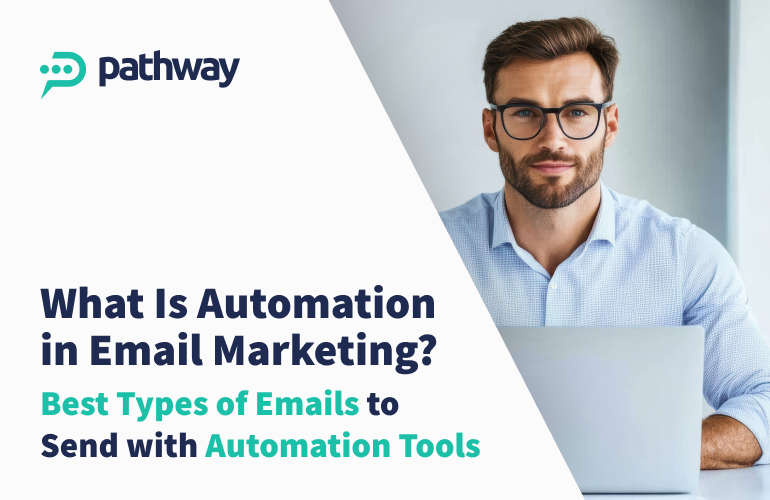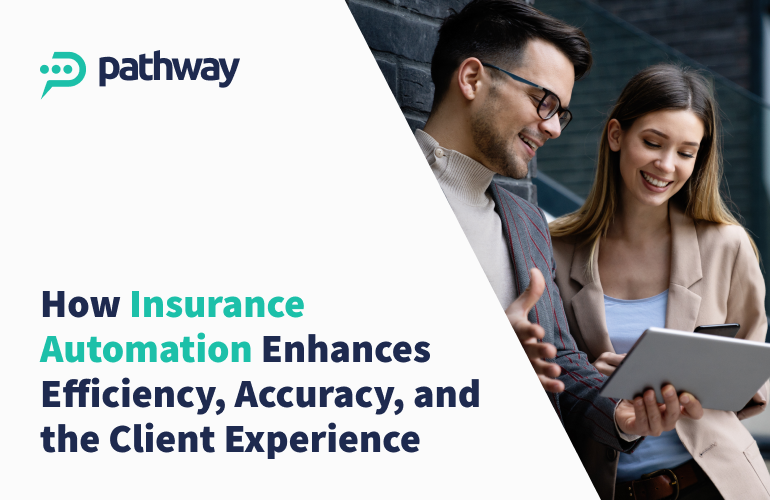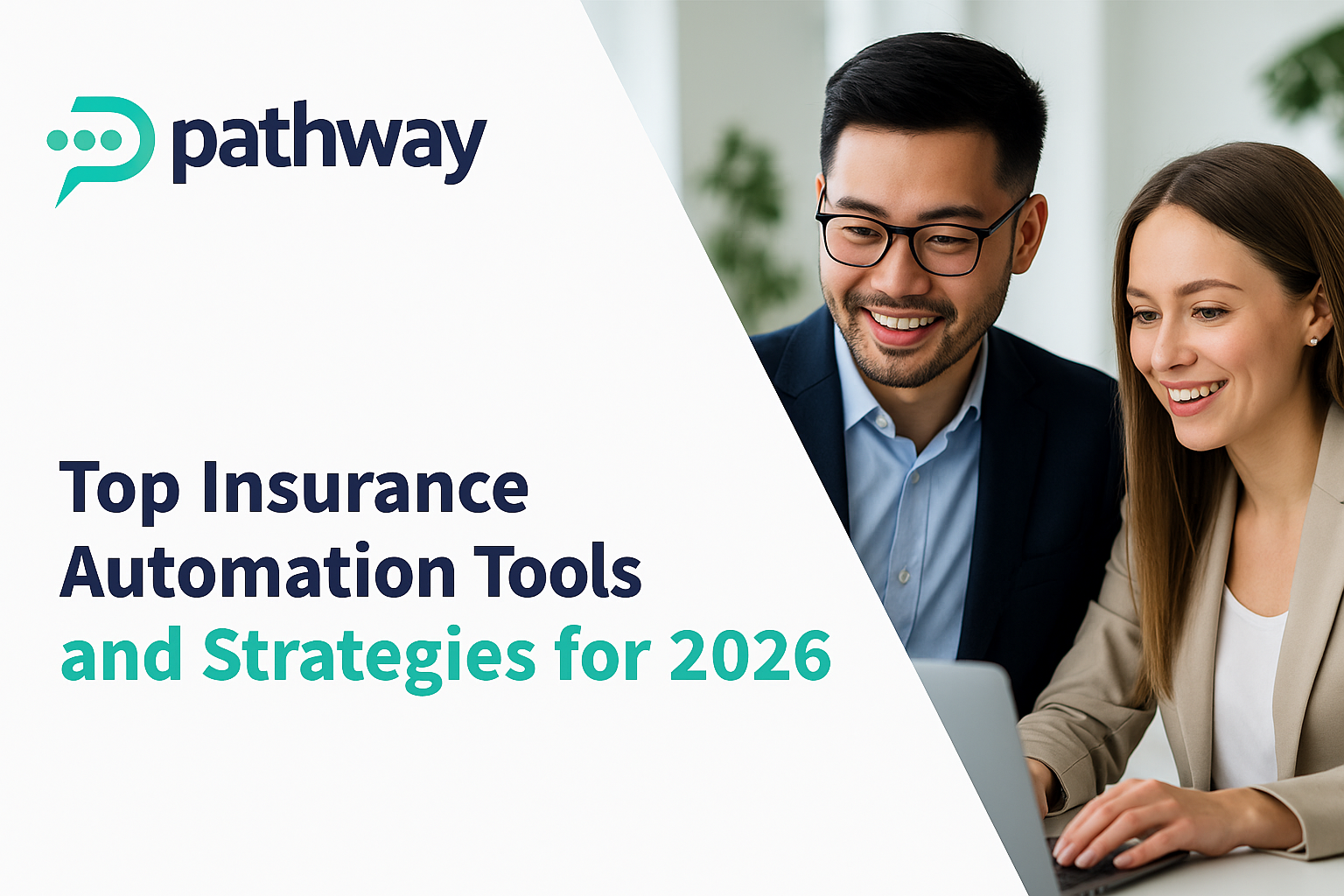
- Introduction: Why Email Marketing Matters for Insurance
- What is Email Marketing Automation for Insurance?
- Benefits of Email Automation for Insurance Agencies
- Types of Automated Emails Every Insurance Agency Should Send
4.1 Welcome Emails
4.2 Re-engagement Emails
4.3 Lead Nurturing Emails
4.4 Feedback Emails (NPS® Surveys)
4.5 Cross-Selling & Up-Selling Emails
4.6 Product Update Emails
4.7 Dedicated Emails
4.8 Internal Update Emails
4.9 Transactional Emails
4.10 Behavioral Emails
5. How PathwayPort Simplifies Email Marketing Automation
6. Pre-built, Branded Templates
7. Workflow Triggers by Event or Interest
8. Multi-Channel Messaging: Email, SMS & Internal Notifications
9. Dynamic Merge Tags for Personalization
10. Policy-Based Segmentation and Timing
Insurance agencies and brokerages today face rising client expectations and limited time. That’s where email marketing automation comes in, as it streamlines communication, saves time, and helps build stronger client relationships.
From welcome emails to renewal reminders, automation allows you to engage leads and retain clients effortlessly. Email remains one of the most powerful tools for agencies and brokerages, offering direct communication, measurable results, and a high ROI, especially when automated.
In this guide, you’ll discover how automation works, which email types perform best, and how platforms like PathwayPort can save your agency or brokerage over 100 hours each year.
What is Automation in Email Marketing?
Email marketing automation refers to the use of a tool to automate email marketing processes. It is a strategy to send out emails to an audience automatically, based on triggers, events, or schedules. Instead of sending each email manually, email marketing automation allows insurance professionals to build workflows that run 24/7. Let’s take a quick look at some of the types of emails you can send using an automation platform.
Common Triggers in Insurance Email Automation:
- New lead submission
- Policy renewal approaching
- Customer inactivity
- Product interest shown (quote request, download, form fill)
Benefits of Email Automation for Insurance Agencies
- Enhance efficiency and time savings
- Deliver timely, personalized communications
- Increase policy renewals, cross-sells & up-selling opportunities
- Improve client satisfaction and referral generation
- Improve lead nurturing
- Consistent brand voice across messages
- Minimize errors & omissions
- eDelivery: send document electronically via email/sms
1. Product update emails
Product update emails often sound like promotional messages. People don’t show interest in such emails. Why? Because promotional content isn’t engaging or interesting. There are so many companies that send weekly or biweekly emails to keep their audience up-to-date with their new products or product features. To produce maximum results for your business, don’t send a slew of emails about product updates blindly. Instead, use an automated system to make strategic use of product update emails. Be sure to add a clear, large headline, a brief description coupled with a high-quality image to showcase your product.

2. Dedicated emails
As a business, you have to send dedicated emails to a specific audience. For instance, if you’re hosting an event and a certain group in your audience might enjoy that event, you can send them dedicated emails. Another example of dedicated send would be monthly emails that are sent to welcome new customers. This means dedicated emails are designed and automated for specific people, and not everybody on your list.
3. Internal updates
Email marketing doesn’t only involve your clients or customers. Your team or employees also need to be engaged and informed. Internal updates, therefore, is a good way to keep everybody informed of new company updates and news. Ideally, internal updates should be clear and simple emails. Whether you want to invite your team to an event or want to make a marketing offer, design internal newsletters in a way that makes things simple and helpful for your employees.
4. Transactional emails
Transactional emails are one-on-one emails that are sent to customers to inform them about the completion of a transaction. For example, if someone buys your product or signs up for your services, you send a transactional email to confirm their order. We often see that in eCommerce when customers receive an automated message that says “Thank you for your purchase”.
5. Marketing Emails
A good marketing email is the one that doesn’t sound like a marketing email. Automating marketing emails in a way that delivers personalized messages to your prospects and customers will help you expand your customer base. Remember, well-written content is a key part of marketing emails. While your emails should be visually appealing, focus on copywriting best practices. Once a marketing email campaign is designed, let an email marketing automation tool take care of the rest of the processes.
6. Behavioral emails
Automated emails can be set up based on actions your customers and prospects take. It’s also called behavioral marketing when you use a marketing platform to send automated emails to people when they interact with your business through your website or social media. Behavioral emails drive quick results and help you understand consumers’ needs.
Best Automated Emails Every Insurance Agency Should Be Sending
Welcome Emails:
Purpose: Welcome emails are sent to new subscribers or clients to introduce your insurance agency or brokerage and set expectations.
Benefits: They build trust from day one, increase engagement, and guide new contacts toward their next steps.
Automation Advantage: Automatically trigger a warm, branded message the moment someone signs up-no manual effort needed.
PathwayPort comes with beautifully designed, pre-built email templates that are ready to use and fully aligned with your brand voice. Whether you’re sending policy renewal reminders, feedback requests, or re-engagement emails, each template is professionally crafted to maintain a consistent tone, look, and feel that matches your agency’s identity. You can easily customize them to reflect your colors, logo, and messaging—so your clients always recognize and trust your communications, without spending hours designing from scratch.
Policy Renewal Reminder Emails:
Purpose: Remind clients of upcoming policy renewals and encourage continued coverage.
Benefits: Reduce policy lapses, increase retention, and prompt clients to reconnect with their agent.
Automation Advantage: With PathwayPort, automated workflows can trigger personalized renewal reminder emails well ahead of key dates. You can set reminders based on renewal timelines, policy types, or client preferences-ensuring timely and relevant communication without lifting a finger.
These emails can highlight the value of staying covered, include a link to speak with an agent, and even suggest potential upgrades or bundling options-making it easy for clients to take action or explore more.
Re-engagement Emails:
Purpose: These emails target inactive clients or leads to bring them back into the conversation.
Benefits: Re-engagement campaigns help recover lost opportunities, reignite interest, and clean your contact list.
Automation Advantage: Send timely nudges based on inactivity rules, ensuring no prospect slips through the cracks.
PathwayPort gives you the opportunity to minimize client churn by sending targeted “Lost Client” emails. By incorporating surveys into your emails, you can gain valuable insight into how your clients perceive your business-whether they’re brand ambassadors who are extremely satisfied or customers who are disappointed and considering ending their services.
For satisfied clients, you can provide a quick and easy link to leave a Google review, helping boost your NPS (Net Promoter Score). For dissatisfied clients, you can automatically notify your internal team and prompt your CSMs to reach out, while also triggering engaging follow-up emails to try to re-engage them before they churn.
Lead Nurturing Emails:
Purpose: Designed to educate and move leads through the sales funnel with relevant info about policies and services.
Benefits: Builds credibility, answers common questions, and increases conversion rates.
Automation Advantage: Deliver a sequence of personalized emails based on the lead’s behavior or stage-automatically.
PathwayPort makes lead nurturing easy and powerful with automated workflows that can be triggered based on specific events, client behavior, or audience interests. Whether a lead requests a quote, downloads a resource, or abandons a form, PathwayPort can instantly launch a personalized email or SMS follow-up, keeping your agency top of mind without any manual effort.
What makes it even more effective is that PathwayPort doesn’t just communicate with clients—it also notifies your team. You can set up internal alerts so your CSMs or sales reps are informed when a high-value lead takes action, helping you respond faster and close more deals.
Additionally, PathwayPort uses powerful merge tags and dynamic content, so emails can be automatically customized based on policy types (auto, home, life, etc.), renewal dates, or even cross-sell and up-sell opportunities. For example, a client with auto insurance can receive a personalized message about bundling with home insurance-completely hands-free.
In short, PathwayPort helps you deliver the right message, to the right person, at the right time, across channels, while keeping your team in the loop.
Feedback Emails and Refferal Campaigns:
Purpose: Feedback emails ask clients to share their experience after a purchase or interaction.
Benefits: Improve your service, gather testimonials, and monitor satisfaction (e.g., NPS).
Automation Advantage: Automatically request feedback post-policy issuance or renewal, no follow-up needed by your team.
With PathwayPort, you can automatically send NPS® surveys to gauge customer satisfaction and identify your most loyal clients. Use that insight to launch referral campaigns, turning happy customers into brand ambassadors and expanding your client base effortlessly. Read our guide: “How to automate your clients’ follow-up?”
Cross-selling/Up-selling Emails:
Purpose: These emails promote additional or upgraded products to existing clients.
Benefits: Increase customer lifetime value, provide more comprehensive coverage, and boost revenue.
Automation Advantage: Suggest the right policies at the right time, based on what the client already has, with zero manual outreach.
How Email Marketing Automation Can Help Your Insurance Business?
Now that we understand the significance of email automation, make sure to find the right tool to automate your campaigns. Every type of email can be automated with an automation tool. However, try to streamline your email marketing with a tool designed specifically for your industry. For example, PathwayPort is a perfect platform for insurance brokerages and companies to automate their email workflows. Choose a system that meets your unique business needs.
How PathwayPort Simplifies Insurance Email Automation
PathwayPort is designed for insurance agencies, offering:
Pre-Built Insurance Email Templates
Get access to ready-made templates for all major use cases: renewals, welcome emails, feedback requests, and more.
Event-Based Workflow Triggers
Launch sequences based on form fills, quote requests, inactivity, or client behavior.
Multi-Channel Messaging
Send communications via email, SMS, or internal notifications from one platform.
Personalization with Dynamic Merge Tags
Automatically tailor messages with client names, policy types, renewal dates, and more.
Segmentation by Policy Type or Lifecycle Stage
Deliver highly targeted emails based on auto, life, or home policies, or by where a client is in their journey.
Launch Referral Campaigns Using NPS Emails
Use PathwayPort to automatically send NPS® surveys post-renewal. Based on responses, trigger:
- Google review requests for promoters
- Follow-up support for detractors
- Referral incentives for satisfied clients
Would You Like to See Automation in Action? Schedule a Short Discovery Call!

FAQs
1. What is email marketing automation?
Email marketing automation is the use of software to send emails automatically based on predefined triggers, schedules, or customer behaviors. Instead of sending emails manually, automation allows you to create workflows that respond to specific actions-like a client requesting a quote, missing a renewal deadline, or providing feedback. For insurance businesses, this means consistently engaging clients with personalized, timely messages without lifting a finger.
Main parts of email automation are:
- Triggers based on different events. PathwayPort offers the most of different triggers.
- Personalization and Brand Voice. PathwayPort offer rich library of pre-set email tmeplates, and newsletter articles.
- Efficiency-save of 100+ of hours by changing manual to automatic
2. What is the best email automation platform for insurance?
The best email automation tools align with your industry, support advanced personalization, integrate with your CRM/BMS/AMS, and offer multi-channel communication.
For insurance agencies and brokerages, PathwayPort stands out. It’s purpose-built for the insurance sector, with ready-to-use templates, smart workflows, and seamless integrations.
While tools like Mailchimp, HubSpot, and ActiveCampaign are popular, they’re generic. PathwayPort, on the other hand, is tailored for brokerages and small agencies-automating policy renewals, lead nurturing, re-engagement, and NPS-based feedback. It also supports SMS, internal team notifications, and dynamic policy-based content.
3. What emails can be automated in insurance?
All major types: welcome, re-engagement, cross-sell, feedback, renewal, transactional, and behavioral.
4. How do you automate your emails?
To automate your emails, you typically:
- Define your goals (e.g., welcome new clients, reduce churn, boost referrals).
- Set up triggers (e.g., form submission, policy renewal, inactivity).
- Create email workflows with personalized content.
- Choose your channels (email, SMS, internal alerts).
- Monitor and optimize based on engagement and conversion metrics.
With PathwayPort, this process is simplified with built-in templates, merge tags, and pre-built automation workflows that let you go live quickly-no complex setup required.






Leave a Comment